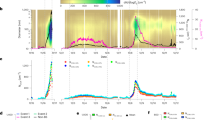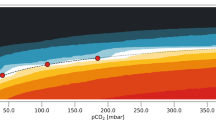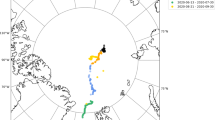Abstract
A SNOWFALL and temperature analysis has been completed for six winter seasons (1948–54) on White Mountain, California (elevation 10,600 ft.). Snowfall and the temperature maxima and minima were measured for every 24 hr. at 0800 Pacific Standard Time. Fig. 1a shows the total snowfall as a function of the mean air temperature of the day on which the snow fell. An interesting peak occurs at − 11 ° C., just as Bossolasco reports1 for the case of snowfall at Weissfluhjoch. Rau's laboratory work2 indicates that the majority of atmospheric nuclei induce freezing between − 10° and − 12° C. Silver iodide begins its activity as a freezing nucleus in the laboratory at − 4° C. 3, and at this point Fig.1a shows another peak. Bossolasco has also mentioned that Mason and Ludlam4 report this point as a secondary maximum in laboratory frequency of atmospheric freezing nuclei. However, it is believed that the − 4° C. peak may be related to large cloud-seeding experiments utilizing silver iodide smoke carried on in the Sierra Nevada Mountains about thirty miles up wind to the west5 during the seasons 1951, 1952 and 1953. Vonnegut6 expected that unusual and far-reaching effects must be expected in the case of such seedings, since silver iodide is much more active than any known natural ice nucleus.
This is a preview of subscription content, access via your institution
Access options
Subscribe to this journal
Receive 51 print issues and online access
$199.00 per year
only $3.90 per issue
Buy this article
- Purchase on Springer Link
- Instant access to full article PDF
Prices may be subject to local taxes which are calculated during checkout
Similar content being viewed by others
References
Bossolasco, M., Nature, 174, 362 (1954).
Rau, W., Schr. deutsch. Akad. Luft., Berlin, 8, 65 (1944).
Schaefer, V. J., “Compendium of Meteorology”, 224 (Amer. Met. Soc., Boston, 1951).
Mason, B. J., and Ludlam, F. H., “Reports on Progress in Physics”, 14, 170 (1951).
Elliott, R. D., and Strickler, R. F., Bull. Amer. Met. Soc., 35, No. 4, 171 (April 1954).
Vonnegut, B., J. App. Phys., 18, 593 (1947).
Hall, F., Henderson, T. J., and Cundiff, S. A., Bull. Amer. Met. Soc., 34, No. 3, 111 (March 1953).
Author information
Authors and Affiliations
Rights and permissions
About this article
Cite this article
D'OOGE, C. Snowfall and Temperature on a California Mountain. Nature 175, 465–466 (1955). https://doi.org/10.1038/175465a0
Issue Date:
DOI: https://doi.org/10.1038/175465a0
This article is cited by
-
Dependence of Snowfall on Temperature
Nature (1956)
Comments
By submitting a comment you agree to abide by our Terms and Community Guidelines. If you find something abusive or that does not comply with our terms or guidelines please flag it as inappropriate.



